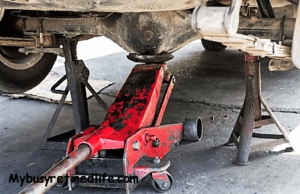Working safe under a car

How not to jack up and support a vehicle.
Working safe under a car should always be the most important consideration when working under a car. The tools known as jack stands and floor jacks are safety items for those who need to work underneath vehicles. Putting up a vehicle on jack stands correctly can be the difference between life and accidental death. Anyone using jack stands must follow some simple safety rules to avoid a potential disaster.
On the level
First thing always work on a level workspace. Never try to jack up a vehicle on an incline or other uneven surfaces, this is extremely unsafe. Make sure the area under the vehicle is correctly paved and firmly supported.
Consult your owner’s manual for information about safe practices for raising your vehicle off the ground.
Find the weight for your vehicle it is usually on the plaque in your driver’s door jam. You don’t want to work under a vehicle where the jack stands can collapse because of to much weight. It’s important to have jack stands with a safety rating for more than the weight of your car or truck.
How to Use Jack Stands

Image courtesy of Stoonn at FreeDigitalPhotos.net
- Set the parking brake. This will prevent the car from moving while it is on the jack stands.
- Use wheel chocks on both sides(front and rear) of the tires that will stay on the ground to prevent the car from moving forward or backward. A car lurching forward or backward can fall off the jack and injure or even kill you. WARNING: Having the car in the Park position on the transmission selector and the use of chocks are essential when the rear wheels are lifted since the parking brake usually sets on the rear wheels. Without a chock, the front wheels can roll even if your parking brake is on.
- Place the floor jack under the appropriate jacking locations on the vehicle and lift the vehicle one side at a time.
No blocks
- Never ever use the floor jack or the jack stands with a block or blocks under them. These blocks make the lift very dangerous.
- Experts recommend using at least two jack stands of the same heights so that the vehicle is supported equally on both sides. Never use jack stands on dirt, wet ground, or hot asphalt since the weight of the car can cause the jack stands to sink into the ground and cause the car can fall off them.
- Always place the jack stands as far apart as safely possible. The wider the distance between the jack stands the more stable the car will be when they support the full car’s weight. Your owner’s manual will likely have information about where to safely support the vehicle with jack stands.
- Lower the car onto the jack stand until it is supporting a little weight. Look at the jack stand feet and make sure all the feet are touching the ground. If not lift the car again and reposition the jack stand until all the feet are on the ground under the weight of the car.
Test them
- After lowering the car onto the jack stands you must test the jack stands for stability by pushing on the corners of the vehicle. You are trying to push the vehicle with your hand to see if it moves or shakes. If it shakes, use the floor jack and reposition the jack stands until the vehicle is stable.
- If the jack stands are stable you will need to position the floor jack so the car is supported by the jack stands and backed up by the additional support of the floor jack. WARNING: the jack stands are still supporting 99.9% of the car’s weight. The floor jack is jacked up to touch the car’s frame or proper support area and provides support but does not take the weight off the jack stands.
Backup is good
- Add backup safety objects. You can put a spare tire(with rim) or blocks of wood under the car to catch the car if it falls. Never, ever, use concrete blocks or bricks since these can crumble under the weight of the falling car.
Most cars come with a jack(like a scissor jack) and wrench from the factory but this jack is not intended for use on the car during maintenance, this jack is designed only for emergency tire changes. For maintenance jobs, use a floor jack that can lift all vehicles.
Get familiar
![By Nerijp (Own work) [GFDL (//www.gnu.org/copyleft/fdl.html) or CC BY-SA 3.0 (//creativecommons.org/licenses/by-sa/3.0)], via Wikimedia Commons Working safe under car Small floor jack](https://upload.wikimedia.org/wikipedia/commons/0/03/Cric-hydraulique.jpg)
Familiarize yourself with the controls of the floor jack before trying to lift the car. Floor jacks are meant to be used on concrete only.
Locate the manufacturer recommended lifting locations for the vehicle. The lift points usually are near the wheels perhaps a notched area in the chassis. Install the floor jack under a solid, structural piece of the vehicle frame if the lift points cannot be used.
Make sure not to put the floor jack under thin metals like the floorboards of the vehicle. This may cause the floor jack to bend or break through the floor. Also, do not put the floor jack under any moving part such as the suspension, steering linkage or driveline of the vehicle.
Follow these simple rules for working safe under a car.
Related Articles: Auto Repair Articles
(Image courtesy of Stoonn at FreeDigitalPhotos.net)
(Image courtesy of Stoonn at FreeDigitalPhotos.net)
